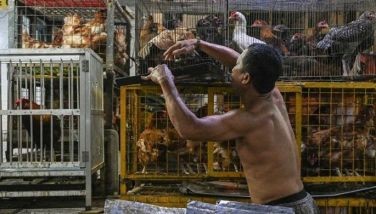20th RP eaglet born in captivity
January 7, 2006 | 12:00am
DAVAO CITY — The Philippine Eagle Center, located in Malagos in Calinan district here, hatched its 20th captive-bred eaglet yesterday.
The latest addition to the center’s 33 eagles reportedly weighed around 138.2 grams when it hatched at around 11:35 a.m. yesterday, 27 hours after it first peeped from its shell.
According to the Philippine Eagle Foundation (PEF), the non-profit organization that runs the center, the eaglet was the 20th hatched there since the center started its captive breeding program in 1992.
"Pag-asa," the first-ever Philippine eagle bred in captivity, is still kept at the Malagos center while five others out of the 20 captive-bred eagles did not survive.
The latest eaglet is said to be the fourth produced by "Tsai" and "Princess Maasim," which also laid the other eaglet that hatched last Nov. 25.
Malagos center personnel are closely monitoring the eaglet since it is expected to have its first intake of food within eight hours after hatching.
The PEF is now looking for possible sponsors willing to shoulder the costs of feeding and caring for the two new eaglets.
At least 17 out of the 33 Philippine eagles kept at the Malagos center are also up for adoption under the facility’s Adopt-An-Eagle program.
Adopting an eagle entails at least P100,000 in annual expenses for the feeding and care of one giant raptor.
According to PEF executive director Dennis Salvador, the two eaglets were the first ones to be hatched at the center’s Elias Lopez incubation and rearing facility that was inaugurated last July.
Salvador expressed confidence that with the new facility, the center would be able to produce more eagles through its captive breeding program in an effort to arrest the continuing decline of the Philippine eagle population.
The new annex is designed to accommodate the expected increase in egg production with the approaching sexual maturity of the first generation of captive-bred eagles the PEF has produced. The rescue of eagles that are too injured or unfit for life in the wild has also brought additional breeding stock to the center.
The facility also features an intensive care area for the rearing of young eagles during the crucial first month of life.
Conservation breeding of the extremely rare eagle species began as far back as the 1970s, when indiscriminate logging and rampant hunting rapidly depleted the eagle population.
The latest addition to the center’s 33 eagles reportedly weighed around 138.2 grams when it hatched at around 11:35 a.m. yesterday, 27 hours after it first peeped from its shell.
According to the Philippine Eagle Foundation (PEF), the non-profit organization that runs the center, the eaglet was the 20th hatched there since the center started its captive breeding program in 1992.
"Pag-asa," the first-ever Philippine eagle bred in captivity, is still kept at the Malagos center while five others out of the 20 captive-bred eagles did not survive.
The latest eaglet is said to be the fourth produced by "Tsai" and "Princess Maasim," which also laid the other eaglet that hatched last Nov. 25.
Malagos center personnel are closely monitoring the eaglet since it is expected to have its first intake of food within eight hours after hatching.
The PEF is now looking for possible sponsors willing to shoulder the costs of feeding and caring for the two new eaglets.
At least 17 out of the 33 Philippine eagles kept at the Malagos center are also up for adoption under the facility’s Adopt-An-Eagle program.
Adopting an eagle entails at least P100,000 in annual expenses for the feeding and care of one giant raptor.
According to PEF executive director Dennis Salvador, the two eaglets were the first ones to be hatched at the center’s Elias Lopez incubation and rearing facility that was inaugurated last July.
Salvador expressed confidence that with the new facility, the center would be able to produce more eagles through its captive breeding program in an effort to arrest the continuing decline of the Philippine eagle population.
The new annex is designed to accommodate the expected increase in egg production with the approaching sexual maturity of the first generation of captive-bred eagles the PEF has produced. The rescue of eagles that are too injured or unfit for life in the wild has also brought additional breeding stock to the center.
The facility also features an intensive care area for the rearing of young eagles during the crucial first month of life.
Conservation breeding of the extremely rare eagle species began as far back as the 1970s, when indiscriminate logging and rampant hunting rapidly depleted the eagle population.
BrandSpace Articles
<
>
- Latest
- Trending
Trending
Latest
Trending
Latest
Recommended

































